| Listing 1 - 10 of 12 | << page >> |
Sort by
|
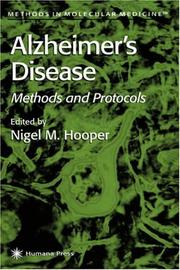
ISBN: 1280821558 9786610821556 1592591957 0896037371 0585395071 Year: 2000 Publisher: Totowa, N.J. : Humana Press,
Abstract | Keywords | Export | Availability | Bookmark
 Loading...
Loading...Choose an application
- Reference Manager
- EndNote
- RefWorks (Direct export to RefWorks)
With the molecular mechanisms underlying the various forms of muscular dystrophy now rapidly clarifying, precise diagnosis has become a reality, and even a requirement in clinical practice. In Muscular Dystrophy: Methods and Protocols, Katherine Bushby and Louise Anderson have assembled an outstanding collection of key techniques for the analysis of DNA and protein from patients suspected to suffer from muscular dystrophy. Each method is highly detailed to ensure success and is presented by a hands-on expert who uses it on a day-to-day basis. The various DNA techniques focus on both the X-linked muscular dystrophies and the autosomal recessive muscular dystrophies. The protein methods include expression analysis, multiplex western blot analysis, immunocytochemical analysis, and reviews of immunological reagants and of amplification systems. Also discussed are the use of animal models to understand human muscular dystrophy and the available options for gene-based therapy. Comprehensive and highly practical, Muscular Dystrophy: Methods and Protocols offers today‚s diagnostic laboratories, basic and medical researchers, and active clinicians an authoritative collection of tools that will serve as exacting diagnostic tools as well as greatly empowering research on the novel therapeutics now beginning to emerge.
Neurology. --- Medicine --- Nervous system --- Neuropsychiatry --- Diseases --- Alzheimer's disease --- Molecular diagnosis --- Molecular aspects --- Diagnosis
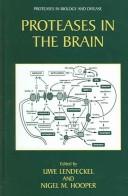
ISBN: 1280613386 9786610613380 0387231013 0387231005 1441935738 Year: 2005 Volume: v. 3 Publisher: New York : Springer,
Abstract | Keywords | Export | Availability | Bookmark
 Loading...
Loading...Choose an application
- Reference Manager
- EndNote
- RefWorks (Direct export to RefWorks)
In all organs of the body proteases have critical roles to play both in normal development and functioning and in disease states. The brain is no exception to this, with proteases having emerging roles in synaptic plasticity, memory, neurodegenerative disorders such as Alzheimer’s, Parkinson’s and prion diseases, ischemia and traumatic brain injury, inflammatory and infectious diseases, and tumour progression. Proteases in the Brain brings together a wide range of topics under this central theme and highlights the large number of proteases involved in these normal and disease processes. Proteases in the Brain reviews the role and regulation of proteases in Alzheimer’s disease brain ischemia and traumatic brain injury human glioma inflammatory and infectious diseases of the central nervous system metabolism of the prion protein modulating synaptic activity multiple sclerosis neuronal plasticity and memory consolidation Parkinson’s disease processing, conversion and inactivation of neuropeptides. Proteases in the Brain is a timely and useful source of information both for those well versed in the role of proteases in the brain and for those who are beginning to realize the important role of this family of enzymes in brain function and dysfunction.
Brain --- Proteinase. --- Brain chemistry. --- Pathophysiology. --- Neurochemistry --- Proteolytic enzymes --- Cerebrum --- Mind --- Central nervous system --- Head --- Analysis and chemistry --- Biochemistry. --- Neurosciences. --- Biochemistry, general. --- Neural sciences --- Neurological sciences --- Neuroscience --- Medical sciences --- Nervous system --- Biological chemistry --- Chemical composition of organisms --- Organisms --- Physiological chemistry --- Biology --- Chemistry --- Composition

ISBN: 1280618671 9786610618675 0387251510 0387251499 1441937757 Year: 2005 Volume: v. 4 Publisher: Dordrecht : Springer,
Abstract | Keywords | Export | Availability | Bookmark
 Loading...
Loading...Choose an application
- Reference Manager
- EndNote
- RefWorks (Direct export to RefWorks)
The ADAM Family of Proteases provides the first comprehensive review of the roles of ADAMs and the related ADAMTS proteases in biology and disease. Although a few members of the ADAM (a disintegrin and metalloprotease) family have been known for some time, it is only in recent years through advances in genome sequencing that the large size of this family of zinc metalloproteases has become apparent. These proteins have multiple domains including a protease domain and a disintegrin domain. A branch of the family, called ADAMTS, also have thrombospondin-like motifs. The role of ADAMs and ADAMTS members in a diversity of biological processes is gradually coming to light. For example, some ADAMs have critical roles in the ectodomain shedding of membrane proteins including tumour necrosis factor-a, the cell signalling molecule Notch and the Alzheimer’s amyloid precursor protein. Other ADAM and ADAMTS family members have key roles to play in sperm function and fertility, collagen processing, development, cardiac hypertrophy and arthritis.
Proteolytic enzymes. --- Proteinase. --- Brain --- Brain chemistry. --- Pathophysiology. --- Peptide hydrolases --- Proteases --- Hydrolases --- Cerebrum --- Mind --- Central nervous system --- Head --- Proteolytic enzymes --- Neurochemistry --- Analysis and chemistry --- Biochemistry. --- Biochemistry, general. --- Biological chemistry --- Chemical composition of organisms --- Organisms --- Physiological chemistry --- Biology --- Chemistry --- Medical sciences --- Composition
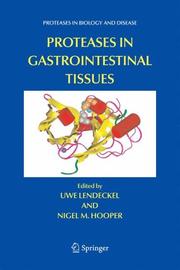
ISBN: 1280625023 9786610625024 1402044836 1402044828 9048171342 Year: 2006 Volume: v. 5 Publisher: Dordrecht ; [Great Britain] : Springer,
Abstract | Keywords | Export | Availability | Bookmark
 Loading...
Loading...Choose an application
- Reference Manager
- EndNote
- RefWorks (Direct export to RefWorks)
This, the fifth volume in the Proteases in Biology and Disease series, is devoted to Proteases in Gastrointestinal Tissues. Of course, proteases play an important role in the digestion and utilization of ingested proteins, but besides that they elicit a wide range of physiological and pathological effects. Proteases have been recognized as essential regulators, acting both locally and systemically, of normal development, growth and functioning. Dysregulation of protease expression and/or enzymatic activity is often associated with the onset or progression of disease and, thus, proteases represent interesting targets for the pharmacological therapy of e. g. cancer, chronic inflammation, graft rejection, fibrosis, diabetes, vascular disease, and viral or bacterial infections. In addition, changes in the localization, abundance or activity of proteases may serve as informative diagnostic or prognostic markers. This volume focuses on stomach, gut, pancreas, and liver and highlights the role of proteases in normal physiology and disease processes involving these tissues. The first chapter by Nigel W. Bunnett and Graeme S. Cottrell reviews the current knowledge about the protease-activated receptors (PARs) in gastrointestinal tissues. Starting with the mechanisms of activation, signal transduction, and regulation of PAR, their role in controlling gastrointestinal functions and the possible involvement in gastrointestinal diseases are summarized. In Chapter 2, Nikhil I. Khushalani and Nithya Ramnath review the role of matrix metalloproteases (MMPs) and their natural inhibitors, TIMPs, in different types of gastric cancer.
Proteinase. --- Gastrointestinal system --- Pathophysiology. --- Gastro-intestinal system --- Gastrointestinal tract --- GI tract --- Tract, Gastrointestinal --- Tract, GI --- Alimentary canal --- Digestive organs --- Proteolytic enzymes --- Gastroenterology. --- Medicine. --- Clinical medicine. --- Oncology. --- Internal medicine. --- Toxicology. --- Biomedicine general. --- Hepatology. --- Cancer Research. --- Internal Medicine. --- Pharmacology/Toxicology. --- Chemicals --- Medicine --- Pharmacology --- Poisoning --- Poisons --- Medicine, Internal --- Tumors --- Medicine, Clinical --- Clinical sciences --- Medical profession --- Human biology --- Life sciences --- Medical sciences --- Pathology --- Physicians --- Internal medicine --- Toxicology --- Diseases --- Gastroenterology . --- Cancer research. --- Pharmacology. --- Biomedicine, general. --- Health Workforce --- Drug effects --- Medical pharmacology --- Chemotherapy --- Drugs --- Pharmacy --- Cancer research --- Gastroenterology --- Physiological effect
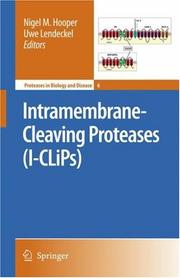
ISBN: 1280944064 9786610944064 1402063113 1402063105 9048176042 Year: 2007 Publisher: Dordrect : Springer,
Abstract | Keywords | Export | Availability | Bookmark
 Loading...
Loading...Choose an application
- Reference Manager
- EndNote
- RefWorks (Direct export to RefWorks)
In recent years a growing number of proteases have been identified that catalyse peptide bond hydrolysis in the plane of the cellular membrane. These so-called ‘intramembrane-cleaving proteases’ (I-CLiPs) are involved in a diverse range of cellular processes, including cell regulation, signalling, quorum sensing, protein processing, lipid metabolism and the unfolded protein response. Some I-CLiPs play critical roles in diseases such as Alzheimer’s and viral infection. The authors, who are all world leaders in this exciting field of cell biology, provide an overview of the various proteases including recent data derived from the structural determination of some of the I-CliPs, and discuss the various roles that these proteases play in biology and disease. The aim of this book is to provide an update on this emerging group of unusual but important proteases for both the specialist and those with a broader interest in proteases. Amongst the target audience will be protease researchers, enzymologists, those working in academia and the pharmaceutical industry on biological processes and diseases involving I-CLiPs.
Endopeptidases. --- Proteolytic enzymes --- Metabolism. --- Peptide hydrolases --- Proteases --- Hydrolases --- Peptide peptidohydrolases --- Peptidase --- Pathology. --- Neurosciences. --- Cytology. --- Cell Biology. --- Cell biology --- Cellular biology --- Biology --- Cells --- Cytologists --- Neural sciences --- Neurological sciences --- Neuroscience --- Medical sciences --- Nervous system --- Disease (Pathology) --- Diseases --- Medicine --- Medicine, Preventive --- Cell biology.
Book
ISBN: 9400726007 904812347X 9786612331138 1282331132 9048123488 Year: 2009 Publisher: Dordrecht : Springer-Verlag,
Abstract | Keywords | Export | Availability | Bookmark
 Loading...
Loading...Choose an application
- Reference Manager
- EndNote
- RefWorks (Direct export to RefWorks)
The 8th volume in the Proteases in Biology and Disease series focuses on the role of proteases in virus function and their potential as anti-viral targets. Viral infections are still difficult to threat and some remained life-threatening diseases in spite of antiviral drug research over decades. Proteases are still regarded as an Achilles’ heel of the pathogens and, thus, protease inhibitors may help to handle the known and the emerging viral threads. The book discusses viral proteases of the most important pathogenic viruses, responsible for severe diseases: AIDS, SARS, Hepatitis, Cytomegalovirus, T-cell lymphotropic virus, Picornavirus. This book focuses specifically on the viral proteases, crucial prerequisites for viral entry into cells and viral replication. Viral proteases represent an important pharmaceutical target. The current stage of protease inhibitor development and therapy are summarised and discussed by experts in the field. This volume represents a timely and valuable continuation of the Proteases in Biology and Disease series. The reader will learn the potential for proteases as targets for effective anti-virals. This book will be a valuable source of information on viral proteases and provoke further research in this important field.
Virus inhibitors. --- Virus inhibitors --- Peptide Hydrolases --- Antiviral Agents --- Protease Inhibitors --- Viruses --- Organisms --- Anti-Infective Agents --- Hydrolases --- Enzyme Inhibitors --- Therapeutic Uses --- Enzymes --- Molecular Mechanisms of Pharmacological Action --- Pharmacologic Actions --- Enzymes and Coenzymes --- Chemical Actions and Uses --- Chemicals and Drugs --- Pharmacy, Therapeutics, & Pharmacology --- Health & Biological Sciences --- Protease inhibitors. --- Proteolytic enzymes. --- Peptide hydrolases --- Proteases --- Proteolytic enzyme inhibitors --- Proteolytic enzymes --- Inhibitors --- Medicine. --- Immunology. --- Medical microbiology. --- Virology. --- Medicinal chemistry. --- Infectious diseases. --- Biomedicine. --- Medical Microbiology. --- Biomedicine general. --- Medicinal Chemistry. --- Infectious Diseases. --- Microbiology --- Immunobiology --- Life sciences --- Serology --- Clinical sciences --- Medical profession --- Human biology --- Medical sciences --- Pathology --- Physicians --- Chemistry, Medical and pharmaceutical --- Chemistry, Pharmaceutical --- Drug chemistry --- Drugs --- Medical chemistry --- Medicinal chemistry --- Pharmacochemistry --- Chemistry --- Enzyme inhibitors --- Microbiology. --- Medical virology. --- Biochemistry. --- Emerging infectious diseases. --- Emerging infections --- New infectious diseases --- Re-emerging infectious diseases --- Reemerging infectious diseases --- Communicable diseases --- Biological chemistry --- Chemical composition of organisms --- Physiological chemistry --- Biology --- Medical microbiology --- Virology --- Virus diseases --- Microbial biology --- Microorganisms --- Composition --- Health Workforce --- Biomedicine, general.
Book
ISBN: 0199632731 019963274X 9780199632732 Year: 1992 Publisher: London Oxford university
Abstract | Keywords | Export | Availability | Bookmark
 Loading...
Loading...Choose an application
- Reference Manager
- EndNote
- RefWorks (Direct export to RefWorks)
Recent developments have revealed that proteins can undergo a diverse range of modifications by lipids which can dramatically effect their structural and functional properties. These modifications include acylation, isoprenylation, and the attachment of glycolipid. Written by acknowledged experts in the field, this unique guide describes the latest biochemical, cell biological, and molecular biological techniques being used in this rapidly expanding area. The book discusses lipid modifications of proteins which play important roles in cellular signalling, protein targeting and cellular growth and differentiation. Detailed protocols are provided for all the key techniques, and the relevant background material is included. The book will be an essential manual for a wide range of scientists studying the modification of protein by lipids, including membrane and protein biochemists, cell biologists, immunologists, bacteriologists, parasitologists, and virologists.
Analytical biochemistry --- Lipoproteins --- Protein Processing, Post-Translational --- Acylation --- Post-translational modification --- Protéines --- chemical synthesis --- Synthesis --- Research --- Methodology --- Modification post-traductionnelle --- Post-translational modification. --- Acylation. --- Methodology. --- Protéines --- Protein Processing, Post-Translational. --- chemical synthesis. --- Co-translational modification --- Cotranslational modification --- Modification, Post-translational --- Post-translation protein modification --- Post-translational protein modification --- Posttranslation protein modification --- Posttranslational modification --- Posttranslational protein modification --- Genetic translation --- Proteins --- Lipids --- Chemical reactions --- Synthesis&delete& --- Research&delete& --- Lipoproteins - Synthesis - Research - Methodology.
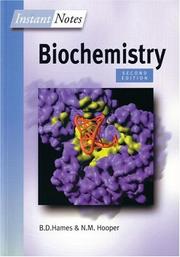
ISBN: 1135324409 9786610100057 1280100052 0203645278 9780203645277 1859961428 9781859961421 6610100055 9781135324407 0387916024 9781135324353 1135324352 9781135324391 1135324395 Year: 2002 Publisher: Oxford BIOS scientific publ.
Abstract | Keywords | Export | Availability | Bookmark
 Loading...
Loading...Choose an application
- Reference Manager
- EndNote
- RefWorks (Direct export to RefWorks)
Naslagwerkwerk op het gebied van de biochemie
Biochemistry --- 577.1 --- 577.1 Chemical bases of life. Biochemistry and bio-organic chemistry generally --- Chemical bases of life. Biochemistry and bio-organic chemistry generally --- 577.1(03) --- DNA deoxyribonucleic acid --- RNA ribonucleic acid --- aminozuren --- antilichamen --- biochemie --- biologie --- celspecialisatie --- cytologie --- enzymen --- koolhydraten --- membranen --- metabolisme --- proteïnen --- rDNA recombinant DNA --- vetten --- .chemische basis van leven. biochemie en bio-organische chemie in het algemeen --- General biochemistry
Book
ISBN: 185578162X Year: 2005 Publisher: London Portland Press
Abstract | Keywords | Export | Availability | Bookmark
 Loading...
Loading...Choose an application
- Reference Manager
- EndNote
- RefWorks (Direct export to RefWorks)
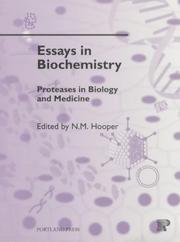
ISBN: 1855781476 Year: 2002 Publisher: London Portland press
Abstract | Keywords | Export | Availability | Bookmark
 Loading...
Loading...Choose an application
- Reference Manager
- EndNote
- RefWorks (Direct export to RefWorks)
| Listing 1 - 10 of 12 | << page >> |
Sort by
|

 Search
Search Feedback
Feedback About UniCat
About UniCat  Help
Help News
News